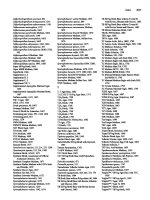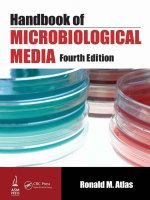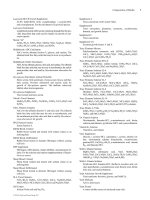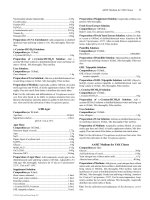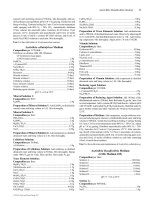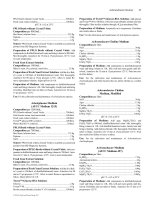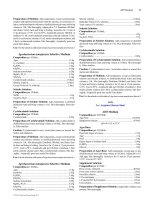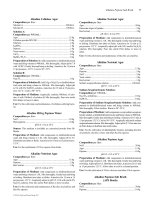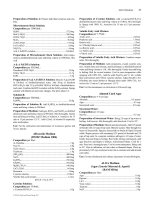Handbook of Microbiological Media, Fourth Edition part 24 ppsx
Bạn đang xem bản rút gọn của tài liệu. Xem và tải ngay bản đầy đủ của tài liệu tại đây (216.88 KB, 10 trang )
Blastobacter denitrificans Agar 225
BL Agar
(Glucose Blood Liver Agar)
Composition per liter:
Agar 15.0g
Glucose 10.0g
Proteose peptone No. 3 10.0g
Pancreatic digest of casein 5.0g
Yeast extract 5.0g
Meat extract 3.0g
Phytone™ 3.0g
Tween™ 80 1.0g
Soluble starch 0.5g
Liver extract 150.0mL
Horse blood 50.0mL
L-Cysteine·HCl solution 10.0mL
Solution A 10.0mL
Solution B 5.0mL
pH 7.2 ± 0.2 at 25°C
Liver Extract:
Composition per 170.0mL:
Liver powder 10.0g
Preparation of Liver Extract: Add 10.0g of liver powder to
170mL of distilled/deionized water. Gently heat to 60°C. Maintain at
50°–60°C for 1 hr. Gently bring to boiling. Boil for 5 min. Adjust pH
to 7.2. Filter through Whatman #2 filter paper.
L-Cysteine·HCl Solution:
Composition per 10.0mL:
L-Cysteine·HCl 0.5g
Preparation of L-Cysteine·HCl Solution: Dissolve 0.5g of L-
cysteine·HCl in distilled/deionized water and bring volume to 10.0mL.
Mix thoroughly. Filter sterilize. Warm to 50°C.
Solution A:
Composition
per 100.0mL:
K
2
HPO
4
10.0g
KH
2
PO
4
10.0g
Preparation of Solution A: Add components to distilled/deionized
water and bring volume to 100.0mL. Mix thoroughly. Autoclave for 15
min at 15 psi pressure–121°C. Cool to 50°–55°C.
Solution B:
Composition
per 100.0mL:
MgSO
4
·7H
2
O 4.0g
NaCl 0.2g
FeSO
4
·7H
2
O 0.2g
MnSO
4
·H
2
O 0.2g
Preparation of Solution B: Add components to distilled/deionized
water and bring volume to 100.0mL. Mix thoroughly. Autoclave for 15
min at 15 psi pressure–121°C. Cool to 50°–55°C.
Preparation of Medium: Add components, except liver extract,
horse blood,
L-cysteine·HCl solution, solution A, and solution B, to
distilled/deionized water and bring volume to 775.0mL. Mix thorough-
ly. Gently heat and bring to boiling. Autoclave for 15 min at 15 psi
pressure–121°C. Cool to 50°–55°C. Aseptically add 150.0mL of sterile
liver extract, 50.0mL of sterile horse blood, 10.0mL of sterile
L-
cysteine·HCl solution, 10.0 mL of sterile solution A, and 5.0mL of ster-
ile solution B. Mix thoroughly. Pour into sterile Petri dishes or distrib-
ute into sterile tubes.
Use: For the cultivation and maintenance of Atopobium minutum,
Bacteroides distasonis, Bacteroides ovatus, Bacteroides thetaiotaomi-
cron, Bacteroides uniformis, Bacteroides vulgatus, numerous Bifido-
bacterium species, Campylobacter divergens, Carnobacterium pisci-
cola, numerous Clostridium species, numerous Lactobacillus species,
Lactococcus lactis, Leuconostoc lactis, Leuconostoc mesenteroides,
and Propionibacterium thoenii.
Blaser’s Agar
See: Campylobacter Selective Medium, Blaser-Wang
Blaser’s Campylobacter Agar
See: Campylobacter Agar, Blaser’s
Blaser-Wang Campylobacter Medium
See: Blaser-Wang
Blaser-Wang Campylobacter Medium
See: Campylobacter Selective Medium, Blaser-Wang
Blastobacter denitrificans Agar
(LMG Medium 157)
Composition per liter:
Agar 15.0g
Tryptone 2.0g
Lab Lemco beef extract 0.5g
Yeast extract 0.5g
Sodium acetate 0.2g
Glucose solution 10.0mL
pH 7.3 ± 0.2 at 25°C
Glucose Solution:
Composition
per 10.0mL:
Glucose 2.5g
Preparation of Glucose Solution: Add glucose to 10.0mL of dis-
tilled/deionized water. Mix thoroughly. Filter sterilize.
Preparation of Medium: Add components, except glucose solu-
tion, to distilled/deionized water and bring volume to 990.0mL. Mix
thoroughly. Autoclave for 15 min at 15 psi pressure–121°C. Cool to
45°–50°C. Aseptically add 10.0mL glucose solution. Mix thoroughly.
Aseptically pour into sterile Petri dishes or distribute into sterile tubes.
Use: For the cultivation of Blastobacter denitrificans.
Blastobacter denitrificans Agar
Composition per liter:
Agar 15.0g
Pancreatic digest of casein 2.0g
Beef extract 0.5g
Yeast extract 0.5g
Sodium acetate 0.2g
Glucose solution 10.0mL
pH 7.2 ± 0.2 at 25°C
Glucose Solution:
Composition
per 10.0mL:
Glucose 2.5g
Preparation of Glucose Solution: Add glucose to distilled/deion-
ized water and bring volume to 10.0L. Mix thoroughly. Filter sterilize.
© 2010 by Taylor and Francis Group, LLC
226 Blastobacter Enrichment Medium
Preparation of Medium: Add components, except glucose solu-
tion, to distilled/deionized water and bring volume to 990.0mL. Mix
thoroughly. Gently heat and bring to boiling. Autoclave for 15 min at
15 psi pressure–121°C. Cool to 50°–55°C. Aseptically add 10.0mL of
sterile glucose solution. Mix thoroughly. Pour into sterile Petri dishes
or distribute into sterile tubes.
Use: For the cultivation of Blastobacter denitrificans.
Blastobacter Enrichment Medium
Composition per liter:
Agar 18.0g
Peptone 0.5g
MgSO
4
·7H
2
O 0.13g
KH
2
PO
4
·3H
2
O 0.13g
pH 7.2 ± 0.2 at 25°C
Preparation of Medium: Add components to tap water and bring
volume to 1.0L. Mix thoroughly. Gently heat and bring to boiling. Dis-
tribute into tubes or flasks. Autoclave for 15 min at 15 psi pressure–
121°C. Pour into sterile Petri dishes or leave in tubes.
Use: For the enrichment and cultivation of Blastobacter species.
Blastobacter Medium
Composition per liter:
Agar 15.0g
Peptone 10.0g
Yeast extract 10.0g
NaCl 5.0g
pH 7.2 ± 0.2 at 25°C
Preparation of Medium: Add components to distilled/deionized
water and bring volume to 1.0L. Mix thoroughly and heat with frequent
agitation until boiling. Autoclave for 15 min at 15 psi pressure–121°C.
Use: For the cultivation and maintenance of Blastobacter natatorius
and other Blastobacter species.
Blastococcus aggregatus Medium
Composition per 1001.0mL:
Tryptone 2.0g
Yeast extract 2.0g
Tris(hydroxymethyl)amino
methane·HCl buffer 1.0g
KNO
3
0.5g
Sodium glycerophosphate 0.1g
Artificial seawater 1.0L
Trace elements solution 1.0mL
pH 7.0 ± 0.2 at 25°C
Artificial Seawater:
Composition
per liter:
Commercially available marine aquarium salts mixture variable
Preparation of Artificial Seawater: Add commercially available
marine aquarium salts mixture. Prepare according to manufacturer’s
recommendations. Mix thoroughly.
Trace Elements Solution:
Composition
per liter:
H
3
BO
3
2.85g
MnCl
2
·4H
2
O 1.8g
Sodium tartrate 1.77g
FeSO
4
1.36g
CoCl
2
·6H
2
O 40.4mg
CuCl
2
·2H
2
O 26.9mg
Na
2
MoO
4
·2H
2
O 25.2mg
ZnCl
2
20.8mg
Preparation of Trace Elements Solution: Add components to
distilled/deionized water and bring volume to 1.0L. Mix thoroughly.
Preparation of Medium: Combine components. Mix thoroughly.
Adjust pH to 7.0. Distribute into tubes or flasks. Autoclave for 15 min
at 15 psi pressure–121°C.
Use: For the cultivation of Blastococcus aggregatus.
Blastocystis Egg Medium
Composition per 1300.0mL:
Homogenized whole egg 783.0mL
Stone's modification
of Locke's solution 217.0mL
Horse serum, heat inactivated 300.0mL
Homogenized Whole Egg:
Composition
per liter:
Whole eggs 18–24
Preparation of Homogenized Whole Egg: Use fresh fertile eggs,
less than 1 week old. Scrub the shells with soap. Let stand in a soap solu-
tion for 30 min. Rinse in running water. Soak eggs in 70% ethanol for 15
min. Break the eggs into a sterile container. Homogenize by shaking. Filter
through four layers of sterile cheesecloth into a sterile graduated cylinder.
Measure out 1.0L.
Stone's Modification of Locke's Solution:
Composition
per liter:
NaCl 8.0g
Na
2
HPO
4
2.0g
NaHCO
3
0.4g
KH
2
PO
4
0.3g
CaCl
2
0.2g
KCl 0.2g
MgCl
2
·6H
2
O 0.01g
Preparation of Stone's Modification of Locke's Solution:
Add components to distilled/deionized water and bring volume to
1.0L. Mix thoroughly.
Preparation of Medium: Distribute homogenized whole egg in
4.0mL volumes into 16 × 125mm screw-capped test tubes. Place tubes
in a slanted position. Inspissate at 80°C (moist heat) for 10 min. Allow
to cool. Add 4.5mL of Stone's modification of Locke's solution to the
surface of the solidified egg in each tube. Close tubes with a rubber
stopper. Place tubes in a press. Autoclave for 15 min at 15 psi pressure–
121°C. Cool to room temperature. Aseptically replace rubber stoppers
with sterile screw caps. Prior to use, aseptically add 1.5mL of heat-in-
activated sterile horse serum to each tube.
Use: For the cultivation of Anophryoides species, Blastocystis hominis,
other Blastocystis species, Endolimax nana, and Metanophrys species.
BLE HiVeg Broth Base
with Listeria Selective Supplement
(Buffered Listeria Enrichment HiVeg Broth Base
with Listeria Selective Supplement)
Composition per liter:
Plant hydrolysate 17.0g
Na
2
HPO
4
,
anhydrous 9.6g
© 2010 by Taylor and Francis Group, LLC
Blood Agar Base 227
Yeast extract 6.0g
NaCl 5.0g
Papaic digest of soybean meal 3.0g
KH
2
PO
4
2.5g
Glucose 2.5g
Sodium pyruvate 1.0g
Listeria selective supplement 5.0mL
pH 7.3 ± 0.2 at 25°C
Listeria Selective Supplement:
Composition
per 5.0mL:
Cycloheximide 50.0mg
Nalidixic acid 40.0mg
Acriflavin hydrochloride 15.0mg
Preparation of Listeria Selective Supplement: Add compo-
nents to distilled/deionized water and bring volume to 5.0mL. Mix
thoroughly. Filter sterilize.
Caution: Cycloheximide is toxic. Avoid skin contact or aerosol for-
mation and inhalation.
Source: This medium, without Listeria selective supplement, is avail-
able as a premixed powder from HiMedia.
Preparation of Medium: Add components, except Listeria selec-
tive supplement, to distilled/deionized water and bring volume to 1.0L.
Mix thoroughly. Gently heat and bring to boiling. Autoclave for 15 min
at 15 psi pressure–121°C. Cool to 45°–50°C. Aseptically add 50.0mL
of sterile Listeria selective supplement. Mix thoroughly.
Use: For the enrichment and isolation of Listeria monocytogenes.
Blood Agar
Composition per liter:
Agar 15.0g
Pancreatic digest of casein 15.0g
Papaic digest of soybean meal 5.0g
NaCl 5.0g
Sheep blood, defibrinated 50.0mL
pH 7.6 ± 0.2 at 25°C
Preparation of Medium: Add components, except sheep blood, to
distilled/deionized water and bring volume to 950.0mL. Mix thorough-
ly. Gently heat and bring to boiling. Autoclave for 15 min at 15 psi
pressure–121°C. Cool to 45°–50°C. Aseptically add 50.0mL of sterile
sheep blood. Mix thoroughly. Pour into sterile Petri dishes in 20.0mL
volumes.
Use: For the cultivation of fastidious microorganisms.
Blood Agar Base
Composition per liter:
Agar 15.0g
Beef extract 10.0g
Peptone 10.0g
NaCl 5.0g
Sheep blood, defibrinated 50.0mL
pH 7.3 ± 0.2 at 25°C
Source: This medium is available as a premixed powder from Oxoid
Unipath.
Preparation of Medium: Add components, except sheep blood, to
distilled/deionized water and bring volume to 950.0mL. Mix thorough-
ly. Heat with frequent agitation and boil for 1 min to completely dis-
solve. Autoclave for 15 min at 15 psi pressure–121°C. Cool to 45°–
50°C. Aseptically add 50.0mL of sterile, defibrinated sheep blood. Mix
thoroughly and pour into sterile Petri dishes.
Use: For the isolation, cultivation, and detection of hemolytic activity
of streptococci and other fastidious microorganisms.
Blood Agar Base
(ATCC Medium 368)
Composition per liter:
Beef heart, infusion from 500.0g
Agar 15.0g
Tryptose 10.0g
NaCl 5.0g
pH 6.8 ± 0.2 at 25°C
Source: This medium is available as a premixed powder from BD Di-
agnostic Systems.
Preparation of Medium: Add components to distilled/deionized
water and bring volume to 1.0L. Mix thoroughly. Heat with frequent
agitation and boil for 1 min to completely dissolve. Autoclave for 15
min at 15 psi pressure–121°C. Cool the basal medium to 45°–50°C.
Aseptically add sterile, defibrinated blood to a final concentration of
5%. Mix thoroughly and pour into sterile Petri dishes.
Use: For the isolation, cultivation, and detection of hemolytic activity
of staphylococci, streptococci, and other fastidious microorganisms.
Blood Agar Base
(BAM M20a)
Composition per liter:
Beef heart, infusion from 500.0g
Agar 15.0g
Tryptose 10.0g
NaCl 5.0g
Sheep blood, defibrinated 50.0mL
pH 6.8 ± 0.2 at 25°C
Preparation of Medium: Add components, except sheep blood, to
distilled/deionized water and bring volume to 950.0mL. Mix thorough-
ly. Heat with frequent agitation and boil for 1 min to completely dis-
solve. Autoclave for 15 min at 15 psi pressure–121°C. Cool to 45°–
50°C. Aseptically add 50.0mL of sterile, defibrinated sheep blood. Mix
thoroughly and pour into sterile Petri dishes.
Use: For the isolation, cultivation, and detection of hemolytic activity
of staphylococci, streptococci, and other fastidious microorganisms.
Blood Agar Base
(Infusion Agar)
Composition per liter:
Agar 15.0g
Pancreatic digest of casein 13.0g
NaCl 5.0g
Yeast extract 5.0g
Heart muscle, solids from infusion 2.0g
Sheep blood, defibrinated 50.0mL
pH 7.3 ± 0.2 at 25°C
Source: This medium is available as a premixed powder from BD Di-
agnostic Systems.
Preparation of Medium: Add components, except sheep blood, to
distilled/deionized water and bring volume to 950.0mL. Mix thorough-
ly. Heat with frequent agitation and boil for 1 min to completely dis-
© 2010 by Taylor and Francis Group, LLC
228 Blood Agar Base
solve. Autoclave for 15 min at 15 psi pressure–121°C. Cool to 45°–
50°C. Aseptically add 50.0mL of sterile, defibrinated sheep blood. Mix
thoroughly and pour into sterile Petri dishes.
Use: For the isolation, cultivation, and detection of hemolytic activity
of streptococci and other fastidious microorganisms.
Blood Agar Base
(Infusion Agar)
(FDA Medium M21)
Composition per liter:
Heart muscle, infusion from 375.0g
Agar 15.0g
Thiotone 10.0g
NaCl 5.0g
pH 7.3 ± 0.2 at 25°C
Preparation of Medium: Add components to distilled/deionized
water and bring volume to 1.0L. Mix thoroughly. Gently heat and bring
to boiling. Distribute into tubes or flasks. Autoclave for 20 min at 15
psi pressure–121°C. Pour into sterile Petri dishes or leave in tubes.
Use: For the cultivation of a variety of microorganisms. For the prep-
aration of blood agar by the addition of sterile blood.
Blood Agar Base with Blood
Composition per liter:
Agar 15.0g
Beef extract 10.0g
Tryptose 10.0g
NaCl 5.0g
Sheep blood, defibrinated 50.0mL
pH 7.3 ± 0.2 at 25°C
Source: This medium without blood is available as a premixed pow-
der from HiMedia.
Preparation of Medium: Add components, except sheep blood, to
distilled/deionized water and bring volume to 950.0mL. Mix thorough-
ly. Heat with frequent agitation and boil for 1 min to completely dis-
solve. Autoclave for 15 min at 15 psi pressure–121°C. Cool to 45°–
50°C. Aseptically add 50.0mL of sterile, defibrinated sheep blood. Mix
thoroughly and pour into sterile Petri dishes.
Use: For the isolation, cultivation, and detection of hemolytic activity
of streptococci and other fastidious microorganisms.
Blood Agar Base, HiVeg with Blood
Composition per liter:
Agar 15.0g
Plant hydrolysate No. 1 10.0g
Plant infusion 10.0g
NaCl 5.0g
Sheep blood, defibrinated 50.0mL
pH 7.3 ± 0.2 at 25°C
Source: This medium without blood is available as a premixed pow-
der from HiMedia.
Preparation of Medium: Add components, except sheep blood, to
distilled/deionized water and bring volume to 950.0mL. Mix thorough-
ly. Heat with frequent agitation and boil for 1 min to completely dis-
solve. Autoclave for 15 min at 15 psi pressure–121°C. Cool to 45°–
50°C. Aseptically add 50.0mL of sterile, defibrinated sheep blood. Mix
thoroughly and pour into sterile Petri dishes.
Use: For the isolation, cultivation, and detection of hemolytic activity
of streptococci and other fastidious microorganisms.
Blood Agar Base, Sheep
Composition per liter:
Pancreatic digest of casein 14.0g
Agar 12.5g
NaCl 5.0g
Peptone 4.5g
Yeast extract 4.5g
Sheep blood, defibrinated 70.0mL
ph 7.3 ± 0.2 at 25°C
Source: This medium is available as a premixed powder from Oxoid
Unipath.
Preparation: Add components to distilled/deionized water and bring
volume to 1.0L. Mix thoroughly. Autoclave for 15 min at 15 psi pres-
sure–121°C. Cool the basal medium to 45°–50°C. Aseptically add
70.0mL of sterile, defibrinated sheep blood. Pour into sterile Petri dish-
es.
Use: For giving improved hemolytic reactions with sheep blood.
Blood Agar Base with Low pH, HiVeg with Blood
Composition per liter:
Agar 15.0g
Plant hydrolysate No. 1 10.0g
Plant infusion 10.0g
NaCl 5.0g
Sheep blood, defibrinated 50.0mL
pH 6. 8 ± 0.2 at 25°C
Source: This medium without blood is available as a premixed pow-
der from HiMedia.
Preparation of Medium: Add components, except sheep blood, to
distilled/deionized water and bring volume to 950.0mL. Mix thorough-
ly. Heat with frequent agitation and boil for 1 min to completely dis-
solve. Autoclave for 15 min at 15 psi pressure–121°C. Cool to 45°–
50°C. Aseptically add 50.0mL of sterile, defibrinated sheep blood. Mix
thoroughly and pour into sterile Petri dishes.
Use: For the isolation and growth of a wide variety of microorgan-
isms. For the detection of the hemolytic reactions of streptococci and
other fastidious microorganisms. The slightly acid pH of this medium
enhances distinct hemolytic reactions.
Blood Agar Base with Peptone
Composition per liter:
Agar 15.0g
Beef extract 10.0g
Peptone 10.0g
NaCl 5.0g
pH 7.3 ± 0.2 at 25°C
Preparation of Medium: Add components to distilled/deionized
water and bring volume to 1.0L. Mix thoroughly. Gently heat and bring
to boiling. Distribute into tubes or flasks. Autoclave for 15 min at 15
psi pressure–121°C. Pour into sterile Petri dishes or leave in tubes.
Use: For use as a base to which blood can be added; for the isolation,
cultivation, and detection of hemolytic activity of streptococci and
other fastidious microorganisms.
© 2010 by Taylor and Francis Group, LLC
Blood Agar Base No. 2 with 1.2% Agar, HiVeg™ 229
Blood Agar Base with 2.5% Sodium Chloride
Composition per liter:
Beef heart, infusion from 500.0g
NaCl 30.0g
Agar 15.0g
Tryptose 10.0g
pH 6.8 ± 0.2 at 25°C
Preparation of Medium: Add components to distilled/deionized
water and bring volume to 1.0L. Mix thoroughly. Heat with frequent
agitation and boil for 1 min to completely dissolve. Autoclave for 15
min at 15 psi pressure–121°C. Cool the basal medium to 45°–50°C.
Aseptically add sterile, defibrinated blood to a final concentration of
5%. Mix thoroughly and pour into sterile Petri dishes.
Use: For the cultivation of Paracoccus halodenitrificans.
Blood Agar Base with 3.5% Sodium Chloride
Composition per liter:
Beef heart, infusion from 500.0g
NaCl 40.0g
Agar 15.0g
Tryptose 10.0g
pH 6.8 ± 0.2 at 25°C
Preparation of Medium: Add components to distilled/deionized
water and bring volume to 1.0L. Mix thoroughly. Heat with frequent
agitation and boil for 1 min to completely dissolve. Autoclave for 15
min at 15 psi pressure–121°C. Cool the basal medium to 45°–50°C.
Aseptically add sterile, defibrinated blood to a final concentration of
5%. Mix thoroughly and pour into sterile Petri dishes.
Use: For the cultivation of Vibrio costicola.
Blood Agar Base with Special Peptone
Composition per liter:
Agar 15.0g
Beef extract 10.0g
Special peptone 10.0g
NaCl 5.0g
Sheep blood, defibrinated 50.0mL
pH 7.3 ± 0.2 at 25°C
Source: Special peptone (L72) is available from Oxoid Unipath.
Preparation of Medium: Add components, except sheep blood, to
distilled/deionized water and bring volume to 950.0mL. Mix thorough-
ly. Heat with frequent agitation and boil for 1 min to completely dis-
solve. Autoclave for 15 min at 15 psi pressure–121°C. Cool to 45°–
50°C. Aseptically add 50.0mL of sterile, defibrinated sheep blood. Mix
thoroughly and pour into sterile Petri dishes.
Use: For the isolation, cultivation, and detection of hemolytic activity
of streptococci and other fastidious microorganisms.
Blood Agar Base No. 2
(BAM M22)
Composition per 1004.0mL:
Agar 12.0g
Proteose peptone 15.0g
NaCl 5.0g
Yeast extract 5.0g
Liver digest 2.5g
Horse blood, defibrinated 50.0mL
FBP solution 4.0mL
pH 7.4 ± 0.2 at 25°C
FBP Solution:
Composition
per 30.0mL:
FeSO
4
0.25g
NaHSO
3
0.25g
Sodium pyruvate 0.25g
Preparation of FBP Solution: Add components to distilled/deion-
ized water and bring volume to 30.0mL. Mix thoroughly. Filter steril-
ize.
Preparation of Medium: Add components, except horse blood and
FBP solution, to distilled/deionized water and bring volume to
950.0mL. Mix thoroughly. Gently heat and bring to boiling. Autoclave
for 15 min at 15 psi pressure–121°C. Cool to 48°C. Aseptically add
50.0mL of sterile horse blood. Mix thoroughly. Aseptically add 4.0mL
sterile FBP solution. Mix thoroughly. Pour into sterile Petri dishes in
20.0mL volumes.
Use: For the cultivation of Brucella spp. and other fastidious bacteria.
Blood Agar Base No. 2, HiVeg with Blood
Composition per liter:
Agar 15.0g
Plant peptone No. 3 15.0g
NaCl 5.0g
Yeast extract 5.0g
Plant extract No. 2 2.5g
Horse blood, defibrinated 70.0mL
Selective supplement 2 vials
pH 7.4 ± 0.2 at 25°C
Source: This medium without blood or supplement is available as a
premixed powder from HiMedia.
Preparation of Medium: Add components, except horse blood and
selective supplement, to distilled/deionized water and bring volume to
930.0mL. Mix thoroughly. Gently heat and bring to boiling. Autoclave
for 15 min at 15 psi pressure–121°C. Cool to 45°–50°C. Aseptically
add 70.0mL of sterile horse blood. Mix thoroughly. Aseptically add 2
vials of rehydrated selective supplement. For Brucella spp. use Brucel-
la selective supplement. For Campylobacter spp. use Campylobacter
supplement-I (Blaser-Wang), or Campylobacter Supplement II (But-
zler), or Campylobacter Supplement III (Skirrow), or Campylobacter
Growth Supplement. For streptococci use Strepto supplement. Mix
thoroughly. Pour into sterile Petri dishes in 20.0mL volumes.
Use: For the cultivation of Brucella spp., Campylobacter spp., Strep-
tococcus spp., and other fastidious bacteria.
Blood Agar Base No. 2 with 1.2% Agar, HiVeg™
Composition per liter:
Plant peptone No. 3 15.0g
Agar 12.0g
NaCl 5.0g
Yeast extract 5.0g
Plant extract No. 2 2.5g
Horse blood, defibrinated 70.0mL
pH 7.4 ± 0.2 at 25°C
Source: This medium without blood is available as a premixed pow-
der from HiMedia.
© 2010 by Taylor and Francis Group, LLC
230 Blood Agar, Diphasic
Preparation of Medium: Add components, except horse blood and
selective supplement, to distilled/deionized water and bring volume to
930.0mL. Mix thoroughly. Gently heat and bring to boiling. Autoclave
for 15 min at 15 psi pressure–121°C. Cool to 45°–50°C. Aseptically
add 70.0mL of sterile horse blood. Mix thoroughly. Aseptically add 2
vials of rehydrated selective supplement. For Brucella spp. use Brucel-
la selective supplement. For Campylobacter spp. use Campylobacter
supplement-I (Blaser-Wang), or Campylobacter Supplement II (But-
zler), or Campylobacter Supplement III (Skirrow), or Campylobacter
Growth Supplement. For streptococci use Strepto supplement. Mix
thoroughly. Pour into sterile Petri dishes in 20.0mL volumes.
Use: For the cultivation of Brucella spp., Campylobacter spp., Strep-
tococcus spp., and other fastidious bacteria.
Blood Agar, Diphasic
Composition per 800.0mL:
Lean beef, desiccated 25.0g
Agar 10.0g
Neopeptone 10.0g
NaCl 2.5g
Locke solution 200.0mL
Rabbit blood, defibrinated 100.0mL
pH 7.2–7.4 at 25°C
Locke Solution:
Composition
per liter:
NaCl 8.0g
Glucose 2.5g
KH
2
PO
4
0.3g
KCl 0.2g
CaCl
2
·2H
2
O 0.2g
Preparation of Locke Solution: Add components to distilled/de-
ionized water and bring volume to 1.0L. Mix thoroughly. Filter steril-
ize.
Preparation of Medium: Add beef to 500.0mL of distilled/deion-
ized water. Let stand for 60 min. Gently heat and bring to 80°C for 5
min. Filter through Whatman #1 filter paper. To filtrate, add remaining
components, except Locke solution and rabbit blood. Mix thoroughly.
Adjust pH to 7.2–7.4 with NaOH. Autoclave for 20 min at 15 psi pres-
sure–121°C. Cool to 45°–50°C. Aseptically add sterile rabbit blood.
Mix thoroughly. Aseptically distribute into sterile tubes in 5.0mL vol-
umes. Allow tubes to cool in a slanted position. Immediately prior to
inoculation, overlay agar in each tube with 2.0mL of sterile Locke so-
lution.
Use: For the cultivation of Trypanosoma species and Leishmania spe-
cies.
Blood Agar, Diphasic Base Medium
Composition per 750.0mL:
Beef 25.0g
Agar 10.0g
Neopeptone 10.0g
NaCl 2.5g
pH 7.2–7.4 at 25°C
Preparation of Medium: Trim beef to remove fat. Add 25.0g of
lean beef to 250.0mL of distilled/deionized water. Gently heat and
bring to boiling. Boil for 2–3 min. Filter through Whatman #2 filter pa-
per. Add agar, neopeptone, and NaCl to filtrate. Bring volume to
750.0mL with distilled/deionized water. Mix thoroughly. Adjust pH to
7.2–7.4. Gently heat and bring to boiling. Autoclave for 15 min at 15
psi pressure–121°C. Pour into sterile Petri dishes or distribute into ster-
ile tubes.
Use: For the cultivation of Trypanosoma species.
Blood Agar with Low pH
Composition per liter:
Beef heart, solids from infusion 500.0g
Agar 15.0g
Tryptose 10.0g
NaCl 5.0g
Sheep blood, defibrinated 50.0mL
pH 6. 8 ± 0.2 at 25°C
Source: This medium is available as a premixed powder from BD Di-
agnostic Systems.
Preparation of Medium: Add components, except sheep blood, to
distilled/deionized water and bring volume to 950.0mL. Mix thorough-
ly. Heat with frequent agitation and boil for 1 min to completely dis-
solve. Autoclave for 15 min at 15 psi pressure–121°C. Cool to 45°–
50°C. Aseptically add 50.0mL of sterile, defibrinated sheep blood. Mix
thoroughly and pour into sterile Petri dishes.
Use: For the isolation and growth of a wide variety of microorgan-
isms. For the detection of the hemolytic reactions of streptococci and
other fastidious microorganisms. The slightly acid pH of this medium
enhances distinct hemolytic reactions.
Blood Agar No. 2
Composition per liter:
Proteose peptone 15.0g
Agar 12.0g
NaCl 5.0g
Yeast extract 5.0g
Liver digest 2.5g
pH 7.4 ± 0.2 at 25°C
Source: This medium is available as a premixed powder from BD Di-
agnostic Systems and Oxoid Unipath.
Preparation of Medium: Add components to distilled/deionized
water and bring volume to 1.0L. Mix thoroughly. Heat with frequent
agitation and boil for 1 min to completely dissolve. Autoclave for 15
min at 15 psi pressure–121°C. Cool the basal medium to 45°–50°C.
Aseptically add sterile, defibrinated blood to a final concentration of
7%. Pour into sterile Petri dishes.
Use: For the isolation, cultivation, and detection of hemolytic activity of
streptococci, pneumococci, and other particularly fastidious microorgan-
isms.
Blood Base Agar
(LMG Medium 45)
Composition per liter:
Agar 15.0g
Lab-Lemco beef extract 10.0g
Special peptones 10.0g
NaCl 5.0g
pH 7.1 ± 0.2 at 25°C
Source: Special peptones is available as a premixed powder from Ox-
oid Unipath.
Preparation of Medium: Add components to distilled/deionized
water and bring volume to 1.0L. Mix thoroughly. Gently heat and bring
© 2010 by Taylor and Francis Group, LLC
Blood Glucose Cystine Agar 231
to boiling. Distribute into tubes or flasks. Autoclave for 15 min at 15
psi pressure–121°C. Pour into sterile Petri dishes or leave in tubes.
Use: For the cultivation and maintenance of heterotrophic bacteria.
Blood Base Agar with Charcoal
(LMG Medium 46)
Composition per liter:
Agar 15.0g
Lab-Lemco beef extract 10.0g
Special peptones 10.0g
NaCl 5.0g
Charcoal 2.0g
pH 7.1 ± 0.2 at 25°C
Source: Special peptones is available as a premixed powder from Ox-
oid Unipath.
Preparation of Medium: Add components to distilled/deionized
water and bring volume to 1.0L. Mix thoroughly. Gently heat and bring
to boiling. Distribute into tubes or flasks. Autoclave for 15 min at 15
psi pressure–121°C. Pour into sterile Petri dishes or leave in tubes.
Use: For the cultivation and maintenance of various bacteria.
Blood Base Agar with Horse Blood
(LMG Medium 47)
Composition per liter:
Agar 15.0g
Lab-Lemco beef extract 10.0g
Special peptones 10.0g
NaCl 5.0g
Horse blood, sterile defibrinated 50.0mL
pH 7.1 ± 0.2 at 25°C
Source: Special peptones is available as a premixed powder from Ox-
oid Unipath.
Preparation of Medium: Add components, except horse blood, to
950.0mL distilled/deionized water and bring volume to 1.0L. Mix thor-
oughly. Gently heat and bring to boiling. Autoclave for 15 min at 15 psi
pressure–121°C. Cool to 45°–50°C. Aseptically add 50.0mL sterile
horse blood. Mix thoroughly. Pour into sterile Petri dishes or distribute
into sterile tubes.
Use: For the cultivation and maintenance of fastidious bacteria.
Blood Base Agar with
Horse Blood, Fumarate, and Formate
(LMG Medium 48)
Composition per liter:
Agar 15.0g
Lab-Lemco beef extract 10.0g
Special peptones, Oxoid 10.0g
NaCl 5.0g
Sodium fumarate 3.0g
Sodium formate 2.0g
Horse blood, sterile defibrinated 50.0mL
pH 7.2 ± 0.2 at 25°C
Preparation of Medium: Add components, except horse blood, to
950.0mL distilled/deionized water and bring volume to 1.0L. Mix thor-
oughly. Gently heat and bring to boiling. Autoclave for 15 min at 15 psi
pressure–121°C. Cool to 45°–50°C. Aseptically add 50.0mL sterile
horse blood. Mix thoroughly. Pour into sterile Petri dishes or distribute
into sterile tubes.
Use: For the cultivation and maintenance of fastidious bacteria.
Blood Free Campylobacter Selectivity HiVeg Agar
Base
Composition per liter:
Agar 12.0g
Plant extract 10.0g
Plant peptone 10.0g
NaCl 5.0g
Charcoal, bacteriological 4.0g
Plant hydrolysate 3.0g
Synthetic detergent No. III 1.0g
FeSO
4
0.25g
Sodium pyruvate 0.25g
Sodium deoxycholate solution 10.0mL
Cefazolin solution 1.0mL
pH 7.4 ± 0.2 at 25°C
Source: This medium, without deoxycholate and cefazolin solutions,
is available as a premixed powder from HiMedia.
Sodium Deoxycholate Solution:
Composition per 100.0mL:
Sodium deoxycholate 10.0g
Preparation of Sodium Deoxycholate Solution: Add sodium
deoxycholate to distilled/deionized water and bring volume to
100.0mL. Mix thoroughly. Gently heat while stirring and bring to boil-
ing. Autoclave for 15 min at 15 psi pressure–121°C. Cool to 25°C.
Cefazolin Solution:
Composition
per 10.0mL:
Cefazolin 0.1g
Preparation of Cefazolin Solution: Add cefazolin to distilled/de-
ionized water and bring volume to 10.0mL. Mix thoroughly. Filter ster-
ilize.
Preparation of Medium: Add components, except cefazolin solu-
tion and sodium deoxycholate solution, to distilled/deionized water
and bring volume to 990.0mL. Mix thoroughly. Heat with frequent ag-
itation and boil for 1 min to completely dissolve. Autoclave for 15 min
at 15 psi pressure–121°C. Cool to 50°–55°C. Add 10.0mL of sterile so-
dium deoxycholate solution and 1.0mL of sterile cefazolin solution.
Mix thoroughly. Pour into sterile Petri dishes.
Use: For the selective isolation of Campylobacter species, especially
Campylobacter jejuni from human feces.
Blood Glucose Cystine Agar
Composition per 100.0mL:
Nutrient agar 85.0mL
Glucose cystine solution 10.0mL
Human blood, fresh 5.0mL
pH 6.8 ± 0.2 at 25°C
Nutrient Agar:
Composition
per liter:
Agar 15.0g
Pancreatic digest of gelatin 5.0g
Beef extract 3.0g
Source: Nutrient agar is available as a premixed powder from BD Di-
agnostic Systems.
© 2010 by Taylor and Francis Group, LLC
232 BM Medium
Preparation of Nutrient Agar: Add components to distilled/de-
ionized water and bring volume to 1.0L. Mix thoroughly. Gently heat
while stirring and bring to boiling. Distribute into tubes or flasks. Au-
toclave for 15 min at 15 psi pressure–121°C. Cool to 45°–50°C.
Glucose Cystine Solution:
Composition
per 50.0mL:
Glucose 12.5g
L-Cystine·HCl 0.5g
Preparation of Glucose Cystine Solution: Add components to
distilled/deionized water and bring volume to 50.0mL. Mix thorough-
ly. Filter sterilize.
Preparation of Medium: To 85.0mL of cooled, sterile agar solu-
tion, aseptically add 10.0mL of sterile glucose cystine solution and
5.0mL of human blood. Mix thoroughly. Pour into sterile Petri dishes
or distribute into sterile tubes.
Use: For the cultivation of Francisella tularensis.
BM Medium
(DSMZ Medium 1192)
Composition per liter:
NaCl 19.45g
MgCl
2
8.8g
Peptone 5.0g
Na
2
SO
3
3.24g
CaCl
2
1.8g
Yeast extract 1.0g
KCl 0.55g
NaHCO
3
0.16g
Ferric citrate 0.1g
KBr 0.08g
SrCl
2
0.03g
H
3
BO
3
0.02g
Na
2
HPO
4
8.0mg
Na
2
SiO
3
4.0mg
NaF 2.4mg
NH
4
NO
3
1.6mg
Biotin 0.02mg
Vitamin B
12
0.001mg
Methanol 4.0mL
pH 7.6 ± 0.2 at 25°C
Preparation of Medium: Add components to distilled/deionized
water and bring volume to 1.0L. Mix thoroughly. Gently heat while
stirring and bring to boiling. Distribute into tubes or flasks. Autoclave
for 15 min at 15 psi pressure–121°C.
Use: For the cultivation of Bacillus methanolicus.
Bosea Medium
(DSMZ Medium 1052)
Composition per liter:
Agar 15.0g
Yeast extract 10.0g
ACES 10.0g
Activated charcoal 2.0g
pH 6.9 ± 0.2 at 25°C
Preparation of Medium: Add components, except agar, to dis-
tilled/deionized water and bring volume to 1.0L. Mix thoroughly. Ad-
just pH to 6.9. Add agar. Gently heat while stirring and bring to boiling.
Distribute into tubes or flasks. Autoclave for 15 min at 15 psi pressure–
121°C. Pour into sterile Petri dishes or leave in tubes.
Use: For the cultivation of Bosea spp.
Brain Heart Infusion Agar
(BAM M24 Medium 2)
Composition per liter:
Agar 15.0g
Pancreatic digest of gelatin 14.5g
Brain heart, solids from infusion 6.0g
Peptic digest of animal tissue 6.0g
NaCl 5.0g
Glucose 3.0g
Na
2
HPO
4
2.5g
pH 7.4 ± 0.2 at 25°C
Source: This medium is available as a premixed powder from BD Di-
agnostic Systems.
Preparation of Medium: Add components to distilled/deionized
water and bring volume to 1.0L. Mix thoroughly. Distribute into tubes
or flasks while shaking to distribute precipitate. Autoclave for 15 min
at 15 psi pressure–121°C. Mix thoroughly. Pour into sterile Petri dish-
es.
Use: For the cultivation of a wide variety of fastidious microorganisms,
including bacteria, yeasts, and molds.
Brain Heart Infusion Agar 0.7%
(BHI Agar 0.7%)
(BAM M23)
Composition per liter:
Pancreatic digest of gelatin 14.5g
Agar 7.0g
Brain heart, solids from infusion 6.0g
Peptic digest of animal tissue 6.0g
NaCl 5.0g
Glucose 3.0g
Na
2
HPO
4
2.5g
pH 5.3 ± 0.2 at 25°C
Source: This medium without agar is available as a premixed powder
from BD Diagnostic Systems.
Preparation of Medium: Add components, except agar, to dis-
tilled/deionized water and bring volume to 1.0L. Mix thoroughly. Ad-
just pH to 5.3 with 1N HCl. Mix thoroughly. Add agar. Gently heat and
bring to boiling. Distribute into tubes. Autoclave for 10 min at 15 psi
pressure–121°C.
Use: For the detection of staphylococcal enterotoxin.
Brain Heart Infusion Broth
(BHI Broth)
(BAM M24 Medium 2)
Composition per liter:
Pancreatic digest of gelatin 14.5g
Brain heart, solids from infusion 6.0g
Peptic digest of animal tissue 6.0g
NaCl 5.0g
Glucose 3.0g
Na
2
HPO
4
2.5g
pH 7.4 ± 0.2 at 25°C
© 2010 by Taylor and Francis Group, LLC
Blue-Green Nitrogen-Fixing Agar 233
Source: This medium is available as a premixed powder from BD Di-
agnostic Systems.
Preparation of Medium: Add components to distilled/deionized
water and bring volume to 1.0L. Mix thoroughly. Distribute into tubes
or flasks while shaking to distribute precipitate. Autoclave for 15 min
at 15 psi pressure–121°C.
Use: For the cultivation of a wide variety of microorganisms, includ-
ing bacteria, yeasts, and molds, especially fastidious species.
Blue-Green Agar
Composition per liter:
Agar 10.0g
NaNO
3
1.5g
MgSO
4
·7H
2
O 0.075g
K
2
HPO
4
0.04g
CaCl
2
·2H
2
O 0.036g
Na
2
CO
3
0.02g
Citric acid 6.0mg
Ferric ammonium citrate 6.0mg
EDTA disodium salt 1.0mg
Vitamin B
12
solution 50.0mL
Trace metal mix A5 1.0mL
pH 7.1 ± 0.2 at 25°C
Trace Metal Mix A5:
Composition
per liter:
H
3
BO
3
2.86g
MnCl
2
·4H
2
O 1.81g
Na
2
MoO
4
·2H
2
O 0.39g
ZnSO
4
·7H
2
O 0.222g
CuSO
4
·5H
2
O 0.079g
Co(NO
3
)
2
·6H
2
O 0.049g
Preparation of Trace Metal Mix A5: Add components to dis-
tilled/deionized water and bring volume to 1.0L. Mix thoroughly.
Vitamin B
12
Solution:
Composition
per 50.0mL:
Vitamin B
12
0.01g
Preparation of Vitamin B
12
Solution: Add vitamin B
12
to dis-
tilled/deionized water and bring volume to 50.0mL. Mix thoroughly.
Filter sterilize.
Preparation of Medium: Add components, except vitamin B
12
so-
lution, to glass-distilled water and bring volume to 950.0mL. Mix thor-
oughly. Heat gently and bring to boiling. Autoclave for 15 min at 15 psi
pressure–121°C. Cool the basal medium to 45°–50°C. Add vitamin B
12
solution. Mix thoroughly. Pour into sterile Petri dishes or distribute into
sterile tubes.
Use: For the cultivation and maintenance of Synechococcus species.
Blue-Green Broth
Composition per liter:
NaNO
3
1.5g
MgSO
4
·7H
2
O 0.075g
K
2
HPO
4
0.04g
CaCl
2
·2H
2
O 0.036g
Na
2
CO
3
0.02g
Citric acid 6.0mg
Ferric ammonium citrate 6.0mg
EDTA disodium salt 1.0mg
Vitamin B
12
solution 50.0mL
Trace metal mix A5 1.0mL
pH 7.1 ± 0.2 at 25°C
Trace Metal Mix A5:
Composition
per liter:
H
3
BO
3
2.86g
MnCl
2
·4H
2
O 1.81g
Na
2
MoO
4
·2H
2
O 0.39g
ZnSO
4
·7H
2
O 0.222g
CuSO
4
·5H
2
O 0.079g
Co(NO
3
)
2
·6H
2
O 0.049g
Preparation of Trace Metal Mix A5: Add components to dis-
tilled/deionized water and bring volume to 1.0L. Mix thoroughly.
Vitamin B
12
Solution:
Composition
per 50.0mL:
Vitamin B
12
0.01g
Preparation of Vitamin B
12
Solution: Add vitamin B
12
solution
to distilled/deionized water and bring volume to 50.0mL. Mix thor-
oughly. Filter sterilize.
Preparation of Medium: Add components, except vitamin B
12
, to
glass distilled water and bring volume to 950.0mL. Mix thoroughly.
Heat gently and bring to boiling. Autoclave for 15 min at 15 psi pres-
sure–121°C. Cool the basal medium to 45°–50°C. Add vitamin B
12
so-
lution. Mix thoroughly. Distribute into sterile tubes or flasks.
Use: For the cultivation and maintenance of Synechococcus species.
Blue-Green Nitrogen-Fixing Agar
Composition per liter:
Noble agar 10.0g
MgSO
4
·7H
2
O 0.075g
K
2
HPO
4
0.04g
CaCl
2
·2H
2
O 0.036g
Na
2
CO
3
0.02g
Citric acid 6.0mg
Ferric ammonium citrate 6.0mg
EDTA disodium salt 1.0mg
Trace metal mix A5 1.0mL
pH 7.1 ± 0.2 at 25°C
Trace Metal Mix A5:
Composition
per liter:
H
3
BO
3
2.86g
MnCl
2
·4H
2
O 1.81g
Na
2
MoO
4
·2H
2
O 0.39g
ZnSO
4
·7H
2
O 0.222g
CuSO
4
·5H
2
O 0.079g
Co(NO
3
)
2
·6H
2
O 0.049g
Preparation of Trace Metal Mix A5: Add components to dis-
tilled/deionized water and bring volume to 1.0L. Mix thoroughly.
Preparation of Medium: Add components to glass-distilled water
and bring volume to 1.0L. Mix thoroughly. Heat gently and bring to
boiling. Autoclave for 15 min at 15 psi pressure–121°C. Check pH af-
ter autoclaving and readjust if necessary. Pour into sterile Petri dishes
or distribute into sterile tubes.
Use: For the cultivation and maintenance of Calothrix, Fischerella,
and Nostoc species.
© 2010 by Taylor and Francis Group, LLC
234 Blue-Green Nitrogen-Fixing Broth
Blue-Green Nitrogen-Fixing Broth
Composition per liter:
MgSO
4
·7H
2
O 0.075g
K
2
HPO
4
0.04g
CaCl
2
·2H
2
O 0.036g
Na
2
CO
3
0.02g
Citric acid 6.0mg
Ferric ammonium citrate 6.0mg
EDTA disodium salt 1.0mg
Trace metal mix A5 1.0mL
pH 7.1 ± 0.2 at 25°C
Trace Metal Mix A5:
Composition
per liter:
H
3
BO
3
2.86g
MnCl
2
·4H
2
O 1.81g
Na
2
MoO
4
·2H
2
O 0.39g
ZnSO
4
·7H
2
O 0.222g
CuSO
4
·5H
2
O 0.079g
Co(NO
3
)
2
·6H
2
O 0.049g
Preparation of Trace Metal Mix A5: Add components to dis-
tilled/deionized water and bring volume to 1.0L. Mix thoroughly.
Preparation of Medium: Add components to glass-distilled water
and bring volume to 1.0L. Mix thoroughly. Heat gently and bring to
boiling. Autoclave for 15 min at 15 psi pressure–121°C. Check pH af-
ter autoclaving and readjust if necessary. Aseptically distribute into
sterile tubes or flasks.
Use: For the cultivation and maintenance of Calothrix, Fischerella,
and Nostoc species.
BMM Agar
Composition per liter:
Agar 15.0g
FeSO
4
·7H
2
O 10.0g
K
2
HPO
4
7.0g
MnSO
4
·H
2
O 6.2g
(NH
4
)
2
SO
4
3.0g
KH
2
PO
4
2.0g
NaCl 2.0g
MgSO
4
·7H
2
O 0.5g
Yeast extract 0.1g
Thiamine·HCl 100.0μg
Biotin 10.0μg
Methanol 10.0mL
pH 7.2 ± 0.2 at 25°C
Preparation of Medium: Add components to distilled/deionized
water and bring volume to 1.0L. Mix thoroughly. Gently heat and bring
to boiling. Adjust pH to 7.2. Distribute into tubes or flasks. Autoclave
for 15 min at 15 psi pressure–121°C. Pour into sterile Petri dishes or
leave in tubes.
Use: For the cultivation and maintenance of Butyribacterium methy-
lotrophicum.
BMM Broth
Composition per liter:
FeSO
4
·7H
2
O 10.0g
K
2
HPO
4
7.0g
MnSO
4
·H
2
O 6.2g
(NH
4
)
2
SO
4
3.0g
KH
2
PO
4
2.0g
NaCl 2.0g
MgSO
4
·7H
2
O 0.5g
Yeast extract 0.1g
Thiamine·HCl 100.0μg
Biotin 10.0μg
Methanol 10.0mL
pH 7.2 ± 0.2 at 25°C
Preparation of Medium: Add components to distilled/deionized
water and bring volume to 1.0L. Mix thoroughly. Adjust pH to 7.2.
Distribute into tubes or flasks. Autoclave for 15 min at 15 psi pressure–
121°C.
Use: For the cultivation and maintenance of Butyribacterium methy-
lotrophicum.
BMPA-α Medium
(Edelstein BMPA-α Medium)
Composition per liter:
Agar 13.0g
Yeast extract 10.0g
ACES buffer (2-[(2-amino-2-oxoethyl)-
amino]-ethane sulfonic acid) 2.0g
Charcoal, activated 2.0g
α-Ketoglutarate 0.2g
Fe
4
(P
2
O
7
)
3
·9H
2
O 0.05g
Antibiotic inhibitor 10.0mL
L-Cysteine·HCl·H
2
O solution 10.0mL
pH 6.9 ± 0.2 at 25°C
Source: This medium is available as premixed vials from Oxoid Un-
ipath.
Antibiotic Inhibitor:
Composition
per 10.0mL:
Anisomycin 0.08g
Cefamandole 4.0mg
Polymyxin B 80,000U
Preparation of Antibiotic Inhibitor: Add components to dis-
tilled/deionized water and bring volume to 10.0mL. Mix thoroughly.
Filter sterilize.
L-Cysteine·HCl·H
2
O Solution:
Composition
per 10.0mL:
L-Cysteine·HCl·H
2
O 0.08g
Preparation of L-Cysteine·HCl·H
2
O Solution: Add L-
cysteine·HCl·H
2
O to distilled/deionized water and bring volume to
10.0mL. Mix thoroughly. Filter sterilize.
Preparation of Medium: Add components, except antibiotic inhib-
itor and
L-cysteine·HCl·H
2
O solution , to distilled/deionized water and
bring volume to 980.0mL. Mix thoroughly. Adjust medium to pH 6.9
with 1N KOH. Heat gently and bring to boiling for 1 min. Autoclave
for 15 min at 15 psi pressure–121°C. Cool to 50°–55°C. Add 10.0mL
of the sterile
L-cysteine·HCl·H
2
O solution and 10.0mL of the sterile
antibiotic solution. Mix thoroughly. Pour into sterile Petri dishes with
constant agitation to keep charcoal in suspension.
Use: For the selective isolation and cultivation of Legionella pneumophila
and other Legionella species.
BMPA-α Medium
(Semiselective Medium for Legionella pneumophila)
Composition per liter:
Agar 15.0g
Yeast extract 10.0g
© 2010 by Taylor and Francis Group, LLC
